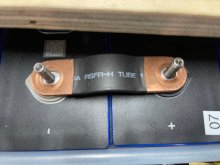Back OT, I circled back and believe I’ve understood that your pack is 8S, correct?
The ‘spring’ data is clear but I’m still confused by the 6 terminal measurements you had - was that center-to-center measurements for the 6 central cells?
The pack I'm prototyping the springs with is 4s. Measurements are cell 1-2, 2-3, 3-4 .. which is why there are 6 measurements.
Spring and PSI info: https://diysolarforum.com/threads/c...lar-10-kw-inverter-rv-build.13786/post-189207
Terminals got closer together from 100 to 0 (between 0.11mm and 0.96mm). I had to disconnect the bus bars to get those measurements (or I'd short out the battery). I measured 3 of the 6 (which wouldn't cause a short) after I recharged the battery and there was no movement. I then disconnected the bus bars and there was still no movement. On the surface, it might appear that attaching solid bus bars at 0% SoC is better than at 100%. I will keep testing now that I have these flexible CALB bus bars:





